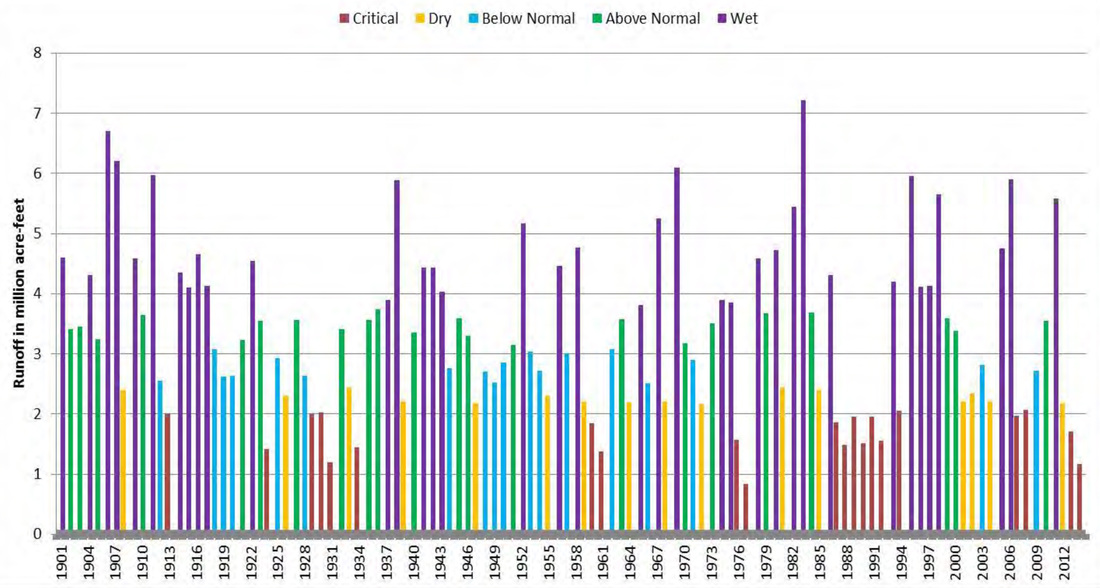"One Watershed" Series
|
#7 Anticipating El Niño: History informs wet winter challenges and opportunities
November 18, 2015
We’ve all heard it: El Niño is coming, and it’s going to be big. It’s already working some of its moistening magic.
As we prepare for a year of heavy rains, some are wondering, “is it possible to have too much rain?” To answer that, let’s journey through the history of El Niño patterns in the Tulare Basin to explore the risk of flood. There’s no better guide for such a journey than the book, "Floods and Droughts in the Tulare Lake Basin,” a 2000-year history of the region’s hydrology, authored by John Austin. “Of the 10 costliest flood years in California since 1950, only four happened during a season when there was an El Niño,” said Austin. “Most of the big floods for us don’t seem to be linked to El Niño,” he said. Most major floods occur during events known as “atmospheric rivers,” which are channels of heavy moisture carried through the atmosphere, like a river. The flood of 1997, known as the "New Year’s Day Flood," was a well-defined atmospheric river that caused more than $1 billion in damages. According to Austin, these sky-flowing rivers are only slightly more prevalent during El Niño years. In other words, the risk of serious flooding this year is anyone’s guess. Regardless, with forecasts of a massive El Niño stirring up both hope and fear, it’s a good time to have informed conversations about the challenges and opportunities presented by heavy rains and floods. Challenges:
Preparation for major flood events is expensive and often ignored because the threat feels unlikely. The Tulare Lake Basin hasn’t experienced any 50-year or 100-year floods in more than 40 years. The Kaweah and Tule Rivers haven’t even seen a 20-year flood or larger since 1969.[1] “Our rivers have been relatively quiet,” said Austin. According to Austin, the fact that our rivers have been calm poses a perception problem. “When we don’t experience a big flood for a while, we tend to forget just how big our floods can be. We have come to think of the federal reservoirs and our levees as protecting us from the effects of big floods, and that isn’t necessarily realistic when we consider our flood history,” said Austin. In the event of a flood like 1861 or 1867, most of Visalia and northwest Tulare County would be flooded, according to a study done by the U.S. Army Corps of Engineers. The 1867-68 flood put 5-6 feet of flood water on Main Street in Visalia, according to Austin’s book.[2] While such a flood may seem unlikely, it is sobering to revisit major floods in more recent history. The following data show the “recurrence intervals” – or the estimated number of years between flood events of equal or greater magnitude – for the four watersheds in the Tulare Basin. Values vary by watershed based on each river’s floodflow volume.
 San Joaquin Valley Water Year Index during the past 114 water years: 1901–2014. The index is a measure of runoff in the San Joaquin River Basin. (Source: CA Department of Water Resources) San Joaquin Valley Water Year Index during the past 114 water years: 1901–2014. The index is a measure of runoff in the San Joaquin River Basin. (Source: CA Department of Water Resources)
Opportunities In these words of flood caution and concern, there is opportunity. It stands to reason that if we could more effectively capture excess rain in wet years and store it in the ground, then we could replenish the immense volume of water we have historically overdrawn from our aquifers. Water districts in the region are increasingly focusing their attention on groundwater recharge as a cost-effective means to ensuring long-term supply. The Kaweah Delta Water Conservation District (KDWCD) has 40 recharge basins, totaling about 5,000 acres, and they are in the process of developing more. “We are always ready for a wet year,” said Mark Larsen, KDWCD General Manager. “It’s been four years waiting for that opportunity… we are hoping to capitalize on a strong El Niño pattern to swing wet and start the recovery process for the diminishing groundwater table,” he said. Further north, the Fresno Irrigation District (FID) is hoping to capture up to 10 feet of Kings River flood flows if El Niño delivers upon forecasts. The District has built four groundwater banking projects in the last decade to capture periodic floodwaters that would otherwise disappear downstream. “It’s worked great for us,” Gary Serrato, general manager of FID, recently told the Los Angeles Times. “We intend to build more.” The volume of water needed to rebuild supplies, however, is immense. On average, the Tulare Basin overdraws groundwater (pumps more than is replenished) by about 1.2 million acre-feet per year. “Since 1860, the Central Valley has lost 38 cubic miles of groundwater, mostly from the Tulare Basin. Some of that capacity has been lost forever to land subsidence, but much of the depleted aquifer space can be replenished,” said Austin. To put that figure into perspective, we’ve depleted the equivalent of more than the volume of Lake Tahoe, enough to cover the entire state of California to a depth of about 15 inches of water.[4] Better water storage is imperative. Proposition 1, passed in 2014, dedicates $2.7 billion toward developing new water storage in California: either above ground or below. Currently, California has 154 major surface water reservoirs with a capacity to store approximately 40 million-acre-feet, filled largely by Sierra Nevada snow runoff.[5] The proposed Temperence Flat reservoir, on the San Joaquin River, would hold up to 1.3 million-acre-feet. Annually, it would yield an average of 67,000 acre-feet of additional water, which is about 6% of the annual water deficit in the Tulare Basin (1.2 million acre-feet).[6],[7] The project is estimated to cost about $2.5 billion to build. Groundwater storage is another option. For $2.7 billion (the Prop. 1 storage allocation), “groundwater storage could provide six times more storage capacity than surface water storage,” according to a 2014 study by Water in the West, a joint program of the Stanford Woods Institute for the Environment and the Bill Lane Center for the American West. Using median costs for both projects, that’s 8.4 million acre-feet of storage versus 1.2.[8] Additional value can be added to groundwater storage projects, according to the study, by building in co-benefits such as flood protection, water recycling, stormwater management, and wildlife enhancement. With co-benefits, the cost rises, but so does the value. Is there potential for a sustainable water supply in the Tulare Basin? Austin and others say yes. Despite new challenges posed by climate change, an all-hands-on-deck approach to solutions like increased groundwater recharge and storage, water conservation, and a shift in forest management will get us there. -- [1] This finding is based on the unimpaired flow of the rivers without factoring in the flood control provided by the reservoirs. (Floods and Droughts in the Tulare Lake Basin, p. 161) [2] Floods and Droughts in the Tulare Lake Basin, p. 158 [3] Ibid., p. 4 [4] Ibid., p. 133 [5] Water in the West, “Storing Water in California: What Can $2.7 Billion Buy Us?” October 2014. [6] Floods and Droughts in the Tulare Lake Basin, p. 136 [7] Bureau of Reclamation releases Draft Feasibility Report for a dam at Temperance Flat, Maven’s Notebook, Feb. 19, 2014 [8] Water in the West, “Storing Water in California: What Can $2.7 Billion Buy Us?” October 2014. Authored by Niki Woodard, Communications Specialist for the Tulare Basin Wildlife Partners and Tulare Basin Watershed Initiative. She has been working with land conservation and watershed health initiatives in the San Joaquin Valley for the past seven years.
|
Mission: To raise awareness about the Tulare Lake Watershed and its unique attributes, challenges, and opportunities. From the snowy peaks to the valley floor, we are one watershed.
This project is made possible through grant funding from the Central Valley Community Foundation, formerly the Fresno Regional Foundation.
This project is part of the Tulare Basin Watershed Initiative.
HELPFUL LINKS:
|






